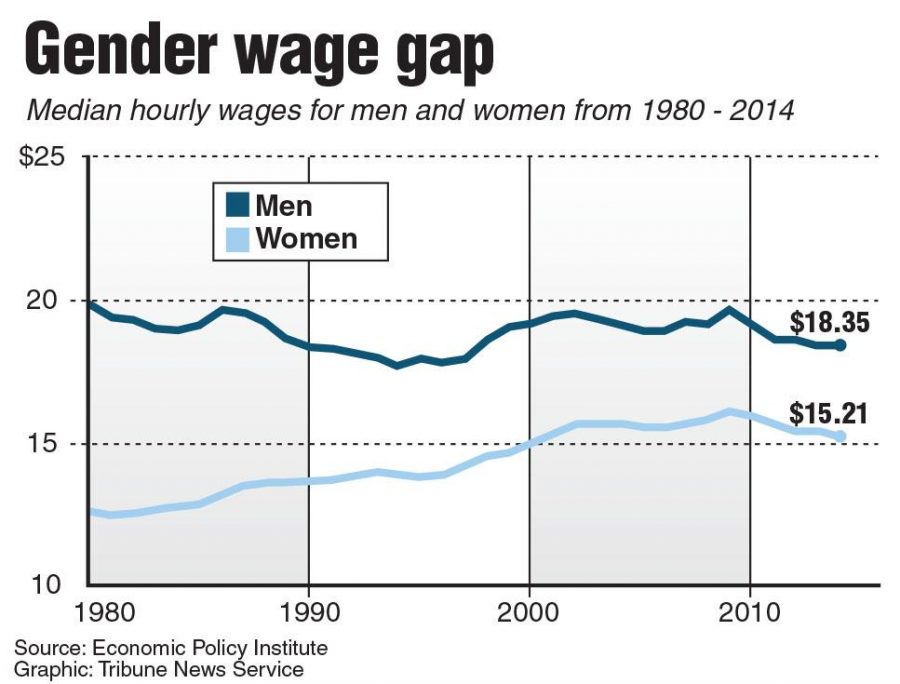Editor’s note: This column is part of a point-counterpoint set of columns on the wage gap. For the corresponding column, see “Point-Counterpoint: The wage gap is unavoidable, not unfair.”
From the suffragettes to second-wave feminists, women and allies have faced vehement opposition from those comfortable with the oppressive norm.
Today, feminists face a different hurdle in their campaigns — those who claim that women have won the battle for equality, particularly in the workplace. While it would be nice if that was the case, it simply isn’t. The wage gap between men and women still exists today, despite what these false prophets might have you believe.
According to the U.S. Census Bureau, the average wage gap between men and women is currently 79 cents. That means for every dollar a man makes, a woman makes 21 cents less, adding up to a $10,762 wage gap between full-time working women and men. It varies by state, with the largest pay difference in Louisiana, where women make an average of 65 cents to every dollar made by their male counterparts. The disparity cuts even deeper for women of color.
Some conservatives attempt to claim that this statistic, as an average, does not demonstrate a wage gap because it does not account for differences in professions. This argument does not hold up, as wage gaps still exist between men and women of the same industry.
Though the problem affects some areas of work less than others, the average man makes more than the average woman in every industry, according to a report from PayScale, an independent organization that collects salary data.
Female graduates of Columbia’s business school — ranked the sixth best business school in the country by Bloomberg’s Businessweek — make an average of $100,000 less than their male counterparts after graduation. Women in finance make an average of $7,000 less per year than men. While in the service industry, women managers make nearly $3 less per hour.
Still, even if the wage gap did only exist between male and female dominated industries, that wouldn’t make it alright, as the mere existence of these divides solidifies our society’s sexism.
Conservatives continue to replace these facts with skewed statistics and excuse the wage gap as a phenomenon that arises from natural tendencies in men and women. To them, these differences ultimately lead women to pursue different careers. This claim is problematic as it implies that men are simply better at higher-paying jobs than women, essentially using a sexist argument to claim that sexism is over.
The only reason that more men end up in STEM related fields than women is because society conditions women to be less confident in their intelligence. Societal forces that discourage women from being vocal, or tell us that boys are just better at certain things — like math — shape women’s perceptions their abilities.
In fact, data from Assessing Women and Men in Engineering — a project that collects data on K-16 education — shows that men are more likely to attribute success to themselves and failure to an outside source, while women are more likely to blame themselves for their failures and credit others for their success.
Despite the fact that studies show boys and girls do equally well in math and science classes in middle and high school, stereotypes condition women to see themselves as unable to handle a rigorous field or curriculum, such as engineering.
If and when conservatives realize that the “difference of jobs” argument doesn’t hold up, they often move on to argue that men and women are paid differently within the same field because women have familial obligations that men don’t.
This societal trend does not justify the wage gap but is another example of arguing against sexism with sexism. Women do not inherently care about their families more than their husbands — they are simply limited in a society that encourages women in the workforce to take on more familial responsibilities.
We struggle without basic legislative support, as the United States does not guarantee paid maternity leave or any substantial paternity leave to new parents. Rather, our society makes it easy for men to work and have a family while making the lives of working mothers a living hell and then blames them for missing projects during maternity leave.
In Norway, we see the opposite case — they have a policy of mandatory maternity and paternity leave for all workers, thus making equal familial responsibility possible for mothers and fathers. Unsurprisingly, employment trends in Norway for men and women are much closer to equal than they are in the United States.
What is most terrifying about the arguments delegitimizing the wage gap is not their implicit sexism, but their encouragement of the notion of post-feminism. Those who argue against the existence of the wage gap do not believe that men and women should not be paid equally, but believe that gender equality has already been reached in the work force.
This sentiment is terrifying, as it encourages women to kick back and relax at a time when women’s rights are constantly under attack — Congress is trying to defund Planned Parenthood, sexual assault rates are still extremely high and data from the Labor Department has shown that the wage gap is not only present but increasing.
It is time to stop arguing over skewed statistics and accept the facts — while the women before us have made massive strides toward equality, sexist policies are still on rampage in our lives. We cannot, and will not, rest until we have not just equal pay, but also equal treatment in society.
Alyssa primarily writes on social justice and political issues for The Pitt News.
Write to her at aal43@pitt.edu


